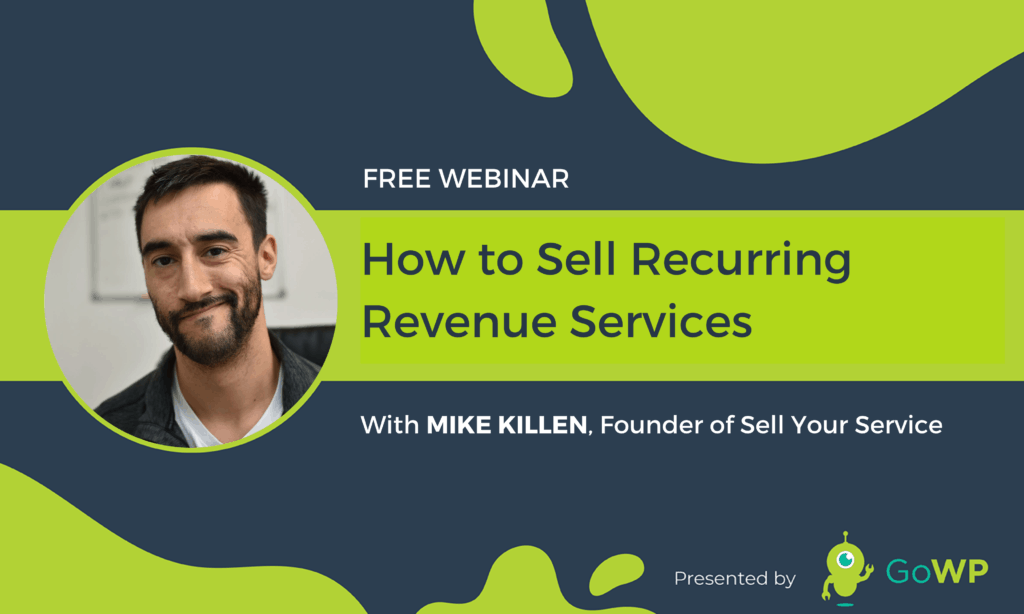
Here are 6 Steps to Selling a Subscription Product
In this blog post I’m going to show you my “6A Method” for selling recurring revenue products to customers and defining what you should deliver to them. I’m Mike Killen, Founder of Sell Your Service, by the way. I partnered with GoWP to help agency owners like you make more money monthly and make more clients happy.
Imagine knowing how much you’ll make, each month, every month. How would that affect your business? How would that affect your life or even your health?
What if you had 100 new clients and it didn’t increase your workload at all? Sounds like nonsense, but in fact is just as possible as any other project you’ve ever sold.
Mike Killen absolutely squashes all your pricing fears, empowers you with authority and nails a method to sell recurring revenue services in this @GoWPSupport post!

#SellYourServices #WordPressJohn Doe Tweet
The Problem
Your business absolutely needs recurring revenue. If you’re chasing customers week in and out for new leads and projects, you’ll end up burning out. I’ve been there and it isn’t pretty.
But your customers already hate paying you right? They already think you’re too expensive. No one has any money! Surely they’d HATE to pay you every month? Or worse still, they say “we expect results” and it makes you feel that you have to justify your prices and monthly costs to them.
The Myth
Newsflash: customers WANT to pay per month. Netflix, Amazon Prime, hosting, gyms, Dollar Shave Club, Geekfuel. All these businesses have a recurring revenue, subscription model. Why?
Because you’re spreading the cost over a year and it makes cash flow much easier to manage. Also, you’re allowing regular checks rather than needing one big solution at the end of the year. Imagine leaving ALL your updates, backups and checkups for a website once a year. “A stitch in time saves nine” comes to mind. One yearly maintenance check would be more than the sum of 52 smaller weekly or even daily checks.
You are the apple a day that keeps the doctor away.
“But I’ve already tried to sell maintenance and my customer’s left…”
I know the feeling of having customers on a care plan, and they end up leaving because they didn’t see results. It’s the classic IT conundrum. When it’s working well they ask “why do we need you?” and when it’s all crashing down they ask “why do we need you?”
This post is going to flip the idea of what a recurring revenue product is, no matter if it’s a care plan or something else.
A Bit About Me
My name is Mike Killen, I’m the Founder of Sell Your Service. All my businesses have been built on recurring revenue because frankly, I didn’t know of any other way. It means that I get to work less, focus on fun stuff and serve more clients because of the process I’ve got below.
Mike’s 6A Method of Selling Anything
I’m going to outline the 6A Method of selling anything from my upcoming book, Five Figure Funnels (you’re getting an exclusive sneak peek!). Audience, amount, asset, authority, attention and action. Follow the 6 checks and you’ll be selling recurring revenue services in no time.

Audience
First, we need to get clear on the type of customer that you’re going to serve with a recurring revenue or subscription product. Most agencies make the mistake of thinking about the product and deliverables first. While of course we’ll need to have a clear idea of the product and what we’re delivering, when we want to sell the subscription or recurring revenue product, we need to think about the customer first.
This is because at its core, you don’t ever sell a product, you sell the customer. In truth, there probably isn’t a massive difference between a maintenance and care product for an accountancy website and blog. But the value and benefits that a user will see after you deliver a care plan will be very different.
Some businesses want security. They’ve been messed around so much that they’re sick of backups and seeing hacked posts on their site. Others are concerned over all the customer data that is stored on the site.
Some businesses are looking for convenience, others want to make sure that when they scale – their site can handle it. Others are so overwhelmed with updates and plugins that it’s just of no interest to them, so they’d rather hand it over.
GoWP handles my membership site and my main marketing site. Why? Well, first of all, I don’t want to have to worry about updates, installs, and backups, I want to focus on my core areas – content and sales. Secondly, my income is totally reliant on how well my site runs. I want to make sure my income is as secure as possible while we scale.
Your key to selling maintenance, subscription, care plans, recurring revenue products, or any other repeat business service is to understand why the person buying it is buying it. Do they want security, freedom, more time, less stress?
All of those are emotive, illogical, and human reasons for doing anything. That’s the driving force behind your audience and why people will buy from you. If you double down and commit to helping your audience achieve a result, the rest is much easier.
Amount
Next comes the fun bit – amount. It’s the price you’re going to charge your customers and how much you need to earn.
This might sound like a bizarre question, surely the market dictates the price? Or your customers tell you what they’re willing to spend? This is where so many WordPress, marketing, website, and social businesses go wrong.
Your price is your price. It’s got nothing to do with anyone else. You need to decide what you want to make per month and then how much you’re going to charge per customer. Let’s say you have a yearly revenue goal of $350,000. Assuming that you also have one off projects from clients, let’s round that down to $200,000 a year in recurring revenue as your goal.
Divided by 12 months, that gives us a target of $16,700 per month. The question then becomes:
- How many customers do you want to serve?
- What are you going to deliver for each of those clients – bearing in mind scalability and communications?
Do you want 10 clients at $1670 per month? Or 100 at $167 per month? Or 1000 at $16.70 per month?
I see so many businesses attempt the recurring revenue or maintenance plan model (which is a killer model by the way) but they don’t ever ask themselves “how much do I want to make?”
In 5 minutes we’ve basically sorted your pricing. No negotiation, no awkward thoughts of “is it too high or too low?” It’s got nothing to do with your competitors or your customers. Your price is your price and now you need to think of something to deliver for that price. The mistake many WordPress businesses make is thinking of what they want to deliver first, then changing the price depending on what the customer says. Or, thinking of what they want to deliver and making up a price for each new customer. That will surely kill your business.
Plus, you’ve got all the parts of “what to deliver” made 100x easier by companies like GoWP (hint).
Assets
Next let’s look at what we’re going to deliver to the customer. You’ve already decided your price (for the sake of argument I’ll use our example above of $167 per month) so now we need to ask ourselves “what can I afford?”
Again, we’re flipping the typical questions on their head. We’re not asking “what can the customer afford?” we’re asking “what can I afford?” This means looking at the price and finding a scalable, profitable delivery list (or assets) that we can give to the customer for the price.
Ultimately – what are you going to give them each month for their money?
At bare minimum, you need a process that you will be delivering to the customer. For example, I know that every week my neighbor gives me some money to do her shopping for her. I have a list of her regular items and I know my way around the supermarket to get what she needs. It’s a documented process that leaves few mistakes and reduces the margin for error.
She’ll get 95% of everything she needs, and it’s much easier for me to do too. Basically, I can shop without thinking. Now ask yourself, in the past, have you ever set up a recurring revenue subscription with a customer, only to find yourself running around at the end of the month fixing a load of things? Do you just jump into their site and update some plugins in a bit of a rush? Or do they email you with a support ticket and you do it, despite never really telling them that was part of the deal. But you’ve done it once so you should do it again and before you know it, your client has landed you with an entire new website project?!
It happens and it’s the #1 reason people give up on recurring revenue products. It’s not enough to set the price, you must also set the terms. Lay out specifically and clearly what the customer is going to get. Ignore the voice in your head that says “I could also add in some reports, or a call. Otherwise they won’t buy!” We’ll talk about selling in a bit.
For now, I need you to honestly and brutally answer “can I afford to deliver XYZ to the customer for this price?”
Look I’m going to level with you. GoWP has literally all this covered. I’m not being paid to write this or say anything along these lines. But for the sake of creating recurring revenue in your business, GoWP’s agency package is LITERALLY what you’re after.
If you’re new to the subscription model or recurring revenue products, just take what they have and white label it for your clients. You can always expand, adapt and grow your offer over time. As a rule, a package that costs you $80 needs to be sold for between $180 and $240 per month. There MUST be a profit margin for you in your products and GoWP is the perfect place to start.
Next, we’ll look at selling your recurring revenue solution to customers and how to justify a price like that.
Authority
The fundamental question that customers are going to ask you is “why should I buy from you?” Every pause, every objection, every Google search, meeting, call, email and proposal is either strengthening your “why” or not.
And the best “why” that you can build for your business, your products and your sales process is authority.
Authority is what customers are looking for before they make a purchase. Deep down customers don’t want to make a bad decision. They want to make a smart decision and they don’t want it to come back and bite them. The only way they can assure themselves that they’re making the right decision, is the level of authority that you bring to the party.
Authority is confidence, it’s expert status, it’s knowing that you’re the best person for the job. Authority is what sells and it’s what customers look for. They turn to experts like you because you’re going to make their life easier.
When I worked as a chef, I remember being told over and over that the customer is happy or unhappy with their meal before they’ve taken the first bite. Yes, taste is important. But people eat with their eyes. They also eat with their hearts. It’s not about what’s just on the plate (although a well presented meal will certainly make it taste better), it’s about the restaurant itself.
Is it clean? What do the menus look like? Are the tables sticky? Do the staff smile and welcome you? What’s the lighting like? All of this makes the meal more or less appealing. The customer is happy with their meal before they’ve eaten it.
The exact same goes for your product. If you’re looking at the price from the previous section and thinking it’s too expensive and “how the heck am I going to justify a price like that!?” you need to build authority.
Just like the customer is happy with their meal before they eat. Your customers will pay more depending on the value you bring upfront. A little trick of mine I’ve used to sell products and services for 5x, 10x and even 20x my competitors, is that I drive a ton of value upfront. The more you give away upfront, the more you can justify a higher price.
Authority isn’t hard to produce either. It’s basically effort. That’s it.
- Blog posts
- YouTube videos
- Podcasts
- Brochures (printed – yes I know)
- Sales pages
- Adverts
- PDF reports
- Testimonials
- Training
Those are just some examples of free authority building content that you could create. As a rule, you’re looking for sales collateral. Stuff that proves your thing is a product that exists.
Which of these two products sounds more legitimate and worth more money?
Product A
- Zero sales pages on the website
- No blog content or training content
- Name keeps changing according to the business
- Proposal takes ages to receive
- No testimonials
Product B
- 2 sales pages on the website
- One talking though the benefits and product
- One talking through how it works
- Onboarding video on YouTube
- Blog post talking through the process
- Product name with simple logo and branding
- Fast proposal and checkout page
- 1 written case study
- 1 user testimonial
If you really worked at it, you could create product B in a week. Products that people trust and use over and over have product names. They have printed collateral. They have content and videos and processes and documentation.
Back to the restaurant. The restaurant that can charge a lot more has a booking process, well designed menus and consistency to their service. The restaurant I trained at in France had plastic covered menus, an alcoholic chef and burned down due to lousy staff. I can assure you that the first restaurant is still there and charging high prices.
Attention
No let’s get you some leads. First of all, you’re probably sitting on a gold mine of leads and potential customers. They’re called customers.
I will never ever ever understand the hesitation to call up previous customers and ask if you can help them. They’ve already bought something from you, they know you. So many businesses are desperate for leads and prospects. Little realising that they are sat on something better – customers!
Your customers are 10x more likely to buy from you. They’re also 1/10th of the price of acquisition of a new customer. Yes, some of them might have thought you were too expensive. Yes, some of them might not want to buy again. But it’s your absolute fastest route to generating sales.
I have a rule at Sell Your Service for helping funnel builders and marketing agencies sell marketing the funnels.
Rule #1 of selling marketing funnels: never talk about marketing funnels
The exact same goes for maintenance plans, care plans, subscription services, care as a service (CaaS) or any other service name. If you want to sell care plans, stop talking about care plans.
Why? Because you don’t sell a product, you sell the customer. Another rule I have at Sell Your Service is Sell Futures, Not Features. Stop selling the thing and start selling what the customer wants in the future.
Which of these sounds more appealing for a gym?
Option A:
Come to our warehouse filled with metal machines and equipment that other people use. Get changed in our changing rooms and leave all your belongings in a metal locker before heading to the gym floor and sweating for 45 minutes before drinking some water. Wait for some people to stop using our weights and machines and then you use them and then wipe them down. Give us $90 a month and you can come whenever you want.
Option B:
Work is hard and going from meeting to meeting brings stress, uncomfortable chairs and snack food. If you ever feel that your office is slowly killing you, we can energize you back to your old self. Our fitness community is there to support you while you get healthy and blow off some steam. We believe your home should be your home, a place to relax and connect with family. That’s why all our state of the art equipment is here for you when you need it. Start getting the body you deserve for a fraction of the price of a home gym.
It might be a little on the nose, but many business owners rely on Option A for selling their care plans. They talk about the features rather than the benefits. They try to sell features, not futures. Instead, start selling the future that the customer wants.
- Less stress when using their own website
- More time to focus on other activities
- No more 2am “backup restore” nights trying to fix a website
- No more back and forth emails to try and fix the website
- Total confidence with new updates and products
- Protect your revenue and lead generation
When you start seeing the hidden benefits to what a care plan can do, you can see how easy it is to get excited about what you’re offering. And when you’re excited, the customer is excited. The mistake that so many website businesses make is trying to get the customer excited about the features. When really, the customer could not care less (even the ones that think they do) about the features.
What they want is more time with the kids. They want more security or confidence. Heck, sometimes customers just want to feel like they’ve got a reliable supplier. All of these are emotional, illogical and human desires and wants. Nothing to do with uptime, delivery speeds or backups numbers.
If you begin to reach out to leads and customers telling them “Hey Brad, I’ve been working on a way to get you out of the office quicker. Also to make your team more productive. Can I show you how?” I promise you’ll start seeing more interest.
Action
Finally, let’s make the sale. At a bare minimum you need a meeting. Why? Because you need to understand what the customer WANTS. What they tell you they want, is what they’re going to buy. I love calls and meetings because the customer essentially gives me a list of things they want to buy.
Two customers could have two completely different wants. That is to say, they have two totally different futures that they’re working towards. But, your single care plan product priced at $199 could help BOTH of them.
Customer A wants to sell the business. After a call with them you discover that they want more leads and sales because they’re looking to sell. They want to retire early, spend more time on their boat and restore an old Morgan car.
Customer B wants to grow the business. They’re looking for sales and leads to increase revenue and drive more customers. They want to grow because you find out, after a little digging, that they were disabled as a child and were constantly told “that’s your lot” and to be happy with what they’ve got. Growing the business is a “screw you” to those that told them that they’d never do anything like this.
These are both real life examples of my customers. And both of them benefitted from my care plans. How? Because the care plans enabled those futures. The care plans allowed those futures to happen or at least made them get their faster and easier.
The deliverables were identical. Both had care plans at $270 a month. Backups, virus sweeps, updates, edits etc. But the way we sold them was by repeating back to them their goals and selling those futures to them.
The care plans allowed Customer A to prove to buyers that he had a secure process and system that prevented outages and loss. His revenue was protected and due diligence saw he was doing everything to enable a clean sale. It also meant that he didn’t need to check the site anymore. He used to look over the WordPress admin because he was the only one who knew how. Now he could pass it on to someone else. Since selling, the customer’s new owner stayed with us.
The care plans allowed Customer B to scale and increase sales and revenue and traffic without worrying what was going to happen to her site. In the past she had seen sales and traffic spikes that killed her site. It took ages to get back up and she lost revenue. Our care plans made sure that as she grew, her site could handle it.
Meetings, proposals, pitches. They’re all based around the potential future that the customer wants. Don’t over complicate the sales process and keep asking the customer “so you want [goal]? Would you like some help with that?”
Finally, for the love of all things holy, please please please get a payment platform set up. Get Stripe or PayPal or SOMETHING to take payments on automation. Invoices for subscriptions are killing your business.
Rule #1 of sales is “make it as easy as possible to take the customer’s money”. If you head to sellyourservice.co.uk/balance you can see I have a payment page. It’s so I can even take deposits and payments for my customers on my phone or laptop or even over the phone. Every product that has a subscription has a payment page that takes payments each month. It’s insane that you still “bill” you customers.
Selling a Subscription Product
So to wrap up, if you want to sell recurring revenue and subscription care products to your customers, start with the audience. Who are you selling to? Who would benefit the most from working with you?
Set your price firm and work backwards from a larger goal. It’s the fastest pricing method in the world and instantly forces you to take care of the third part – assets. Define what you’re going to deliver to the customer. Next make sure your product has authority with sales content, a logo, a product name and some kind of proof that it’s worth buying.
Finally, draw attention to the product by focusing on the benefits and futures that it delivers. Reach out to current customers and ask for a meeting to sell what they want, not what you have.
Starting from Scratch?
If you’re literally starting from scratch, with zero leads and clients – follow the exact same process and start reaching out to friends, family, colleagues, network partners and anyone else. Tell them WHO you work with and WHAT they get.
“Hey Brad. I want to work with CEOs looking to sell their business. Do you know anyone who fits that criteria? I’ve got a blog post to share with them.”
You only need a handful of people to get back to you and you’ll start picking up momentum. If you have zero customers, work on your authority and start telling people who you work with.
Last note, when you land these customers be sure you have a solid client onboarding process in place!
Next steps
- Identify your core audience and try to get on some calls
- Use GoWP to take care of the delivery
- Check out my free training on How to choose a niche for your agency
I’ve loved writing up this post for you and for GoWP. As I mentioned, I haven’t been paid to do this, I genuinely believe they are one of the best possible partners for your business to enable scale.
If you have any questions, please feel free to email me michael@sellyourservice.co.uk or tag me in the GoWP Niche Owners Facebook Group!
Have courage, commit, take action.
Mike










